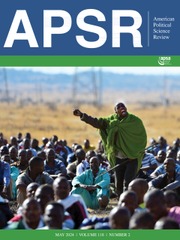Crossref Citations
This article has been cited by the following publications. This list is generated based on data provided by
Crossref.
Krehbiel, Keith
2003.
The Coefficient of Party Influence.
Political Analysis,
Vol. 11,
Issue. 1,
p.
95.
Carey, John M.
and
Reinhardt, Gina Yannitell
2003.
Impacto das instituições estaduais na unidade das coalizões parlamentares no Brasil.
Dados,
Vol. 46,
Issue. 4,
p.
773.
Bawn, Kathleen
and
Rosenbluth, Frances McCall
2003.
Coalition Parties Versus Coalitions of Parties: How Electoral Agency Shapes the Political Logic of Costs and Benefits.
SSRN Electronic Journal,
REMINGTON, THOMAS F.
2003.
Majorities without Mandates: The Russian Federation Council since 2000.
Europe-Asia Studies,
Vol. 55,
Issue. 5,
p.
667.
Carey, John M.
2003.
Transparency Versus Collective Action.
Comparative Political Studies,
Vol. 36,
Issue. 9,
p.
983.
Schaffner, Brian F.
Wagner, Michael W.
and
Winburn, Jonathan
2004.
Incumbents Out, Party In? Term Limits and Partisan Redistricting in State Legislatures.
State Politics & Policy Quarterly,
Vol. 4,
Issue. 4,
p.
396.
CLINTON, JOSHUA
JACKMAN, SIMON
and
RIVERS, DOUGLAS
2004.
The Statistical Analysis of Roll Call Data.
American Political Science Review,
Vol. 98,
Issue. 2,
p.
355.
CAREY, JOHN M.
and
REINHARDT, GINA YANNITELL
2004.
State‐Level Institutional Effects on Legislative Coalition Unity in Brazil.
Legislative Studies Quarterly,
Vol. 29,
Issue. 1,
p.
23.
Langbein, Laura
and
Spotswood‐Bright, Kim
2004.
Efficiency, Accountability, and Private Government: The Impact of Residential Community Associations on Residential Property Values*.
Social Science Quarterly,
Vol. 85,
Issue. 3,
p.
640.
Martorano, Nancy
2004.
Cohesion or Reciprocity? Majority Party Strength and Minority Party Procedural Rights in the Legislative Process.
State Politics & Policy Quarterly,
Vol. 4,
Issue. 1,
p.
55.
Poole, Keith T.
2005.
Spatial Models of Parliamentary Voting.
Yoshinaka, Antoine
and
Grose, Christian R.
2005.
Partisan Politics and Electoral Design: The Enfranchisement of Felons and Ex-Felons in the United States, 1960–99.
State and Local Government Review,
Vol. 37,
Issue. 1,
p.
49.
Hale, Henry E.
2005.
Why Not Parties in Russia?.
Trautman, Karl G.
2005.
A Political Scientist Accepts Ambiguity and Loses Control: My Experience inside the Legislative Process.
PS: Political Science & Politics,
Vol. 38,
Issue. 2,
p.
269.
Battista, James Coleman
2006.
Jurisdiction, Institutional Structure, and Committee Representativeness.
Political Research Quarterly,
Vol. 59,
Issue. 1,
p.
47.
JENKINS, SHANNON
2006.
The Impact of Party and Ideology on Roll‐Call Voting in State Legislatures.
Legislative Studies Quarterly,
Vol. 31,
Issue. 2,
p.
235.
Masket, Seth E.
2007.
It Takes an Outsider: Extralegislative Organization and Partisanship in the California Assembly, 1849–2006.
American Journal of Political Science,
Vol. 51,
Issue. 3,
p.
482.
Magar, Eric
2007.
The Incidence of Executive Vetoes in Comparative Perspective: The Case of American State Governments, 1979-1999.
SSRN Electronic Journal,
Wright, Gerald C.
2007.
Do Term Limits Affect Legislative Roll Call Voting? Representation, Polarization, and Participation.
State Politics & Policy Quarterly,
Vol. 7,
Issue. 3,
p.
256.
SCHAFFNER, BRIAN F.
2007.
Political Parties and the Representativeness Of Legislative Committees.
Legislative Studies Quarterly,
Vol. 32,
Issue. 3,
p.
475.



Comments
No Comments have been published for this article.